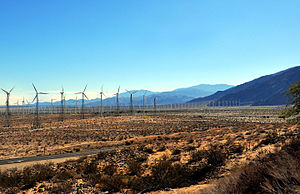Low Desert

The Low Desert (colloquially referred to as the Desert within the region) is a common name for any desert in California that is under 2,000 feet (609.6 m) in altitude. These areas include, but are not exclusive to, the Colorado Desert and Yuha Desert branches of the Sonoran Desert, in the far southeasternmost portion of Southern California. The Low Desert is distinguished in biogeography from the adjacent northern High Desert or Mojave Desert by latitude, elevation, animal life, climate, and native plant communities.[1][2]
Communities
The cities and towns in the Low Desert include:
- Coachella Valley area
- Imperial Valley area
- Lower Colorado River Valley area
- Salton Sea area
- Borrego Springs
- Ocotillo Wells
Parks and Protected Areas
- Anza-Borrego Desert State Park
- Coachella Valley Preserve
- Joshua Tree National Park – Southern portion of the Park is included in the Low Desert, the northern portion is within the Mojave Desert
- Salton Sea State Recreation Area
- Indio Hills Palms Park
- Santa Rosa and San Jacinto Mountains National Monument
- Big Morongo Canyon Preserve
Wildlife refuges and wilderness areas
- Coachella Valley National Wildlife Refuge
- Imperial National Wildlife Refuge
- Havasu National Wildlife Refuge
- Cibola National Wildlife Refuge
- Sonny Bono Salton Sea National Wildlife Refuge
- Fish Creek Mountains Wilderness
- Santa Rosa Wilderness
- Indian Pass Wilderness
- Whipple Mountains Wilderness
- Sawtooth Mountains Wilderness
- Little Picacho Wilderness
See also
- Category:Populated places in the Colorado Desert
- Category:Protected areas of the Colorado Desert
- Category:Wilderness areas within the Lower Colorado River Valley
- Category:Flora of the California desert regions
- Category:Mountain ranges of the Colorado Desert
References
- ^ Deserts at California Natural Resources Agency web site Archived 2013-05-04 at the Wayback Machine
- ^ "California Deserts 101: High Desert vs Low Desert". Sand-boarding.com. Retrieved 12 June 2023.

